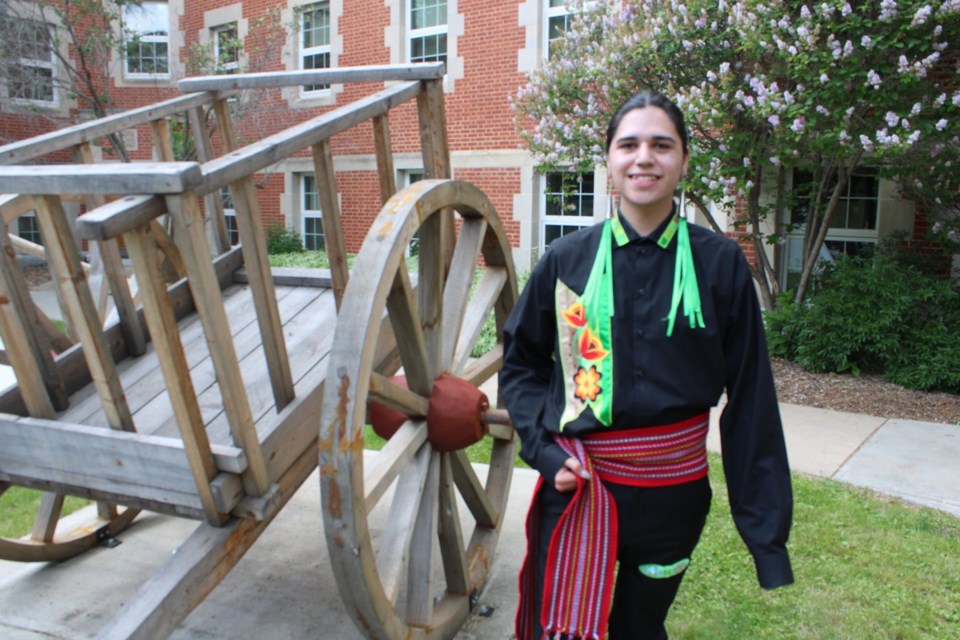(ANNews) – Jigging is a traditional Métis dance that’s existed on Turtle Island for hundreds of years and has been passed down for generations. Nineteen-year-old Kenton Alook is a two-spirit Cree/Métis dancer who is helping to keep the jigging tradition alive. From Bigstone Cree Nation they currently reside in Edmonton where they are studying Native Studies at the University of Alberta. They compete in jigging competitions across the Métis community, and they also take bookings for jigging performances and offer jigging workshops. Through their performances and workshops, Alook is preserving and promoting the beauty of Métis culture and heritage.
“I started jigging when I was in grade 6, so it’s been about 9 years now,” Alook explained in a June interview with ANNews. “I started jigging mainly because I had seen a square dancing group perform in my community for a school assembly and I was really intrigued. So, eventually my mom signed me up for that square dancing group because they were missing a member and I just started with them. I think I was dancing with them for 2 years and then I quit the group when I moved to Edmonton for high school. The group was called the Northern Reelers and our manager was Helen Brule.”
Initially jigging started as just another way for Alook to dance, since they always loved dancing when they were growing up. But then they began seeing jigging as a way to preserve and celebrate Métis culture. “After I learned about residential schools and all the atrocities that happened to us and I learned about the Indian act and all these things that restricted us, I started to appreciate jigging more because it was preserved through our elders and their teachers.”
Alook spoke about how today many Métis youth don’t jig. “Not a lot of our young people jig…There’s not many jiggers to begin with,” said Alook. “I think a lot of Métis people just don’t claim that part of themselves because of the shame. I’ve known a few Métis people who’ve started to reconnect because of their families who never talked about that part of themselves. I think that’s part of why not many people jig.”
When asked about advice they would have for Métis people who would want to reconnect with their culture and learn to jig, Alook advised researching information on Métis culture and history through Google, and watching YouTube tutorials on jigging. They recommended the YouTube jigging tutorials by Madelaine McCallum.
“Then at some point [they] could start being like: Okay, I have a little background on this and I can understand why my family hasn’t been proud of this or why they would want to hide this information. Then they could start to go to cultural events or jigging competitions or Métis festivals because those happen pretty much everywhere especially in Manitoba and the eastern provinces – and I know there’s a few around Alberta.”
Alook also gave insights on jigging competitions. In jigging competitions, participants are divided by age and gender and dance to Métis fiddle music. Métis jig dances include the Red River Jig, the Orange Blossom Special, the Broom Dance and the Sash Dance. Competitors perform basic steps and steps called “changes.” Alook explained that different types of “changes” can be learned from different Métis communities as many variations exist. They additionally mentioned that judges in jigging competitions usually prefer seeing traditional jigging steps over contemporary steps.
Alook explained that with traditional jigging there can’t be any arm movement and with traditional steps you can’t raise your leg or foot above your ankle. “One thing I noticed is that traditional steps take a lot of mental effort to do,” they added. “Part of it is because of how technical the movement is.”
However, with contemporary jigging arm movements are allowed and steps are allowed to be more fancy. Alook briefly spoke about the Ivan Flett Memorial Dancers who incorporate breakdancing into their jigging dances as an example of contemporary jigging.
“I’ve started to appreciate traditional steps a lot more, because of how technical they are to do and they’re a bit harder. But for contemporary or fancy steps, I think it’s a way to get our youth back into jigging and back into seeing how cool these things are,” Alook said. “Jigging needs to evolve with the times we’re in because we should be able to adapt to the times we’re in.”
“Jigging itself was born out of combining 2 different cultures. Some footwork comes from powwow dancing and powwow steps, while the fiddle comes from [Europe],” Alook explained. That’s why Alook thinks it wouldn’t hurt if jigging incorporated more modern styles of dance steps. However, Alook also acknowledged the importance of traditional steps. “But it is good to recognize where we come from. It’s good to recognize the root of the dance and to keep that alive because I think that’s also really important.”
When asked if there was anything else they would like to say about jigging, Alook said: “When witnessing jigging don’t be afraid to clap after the music. Jigging is very uplifting and upbeat. I believe Madelaine McCallum mentioned in her [YouTube] video that when you hear the Red River Jig you just want to get up and dance.”
Alook spoke about how historically jigging was a very inviting dance that helped in making social connections during the fur trade. “Jigging was also used to attract fur traders to Métis posts so that they could trade with them. So it was like: Come join us, come dance. There’s a party at my house later, like we’ll dance there. I’m pretty sure that’s a big part of how jigging was.”



